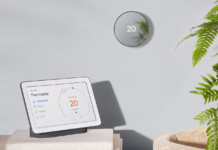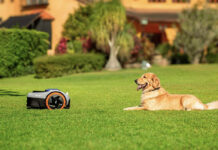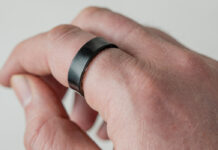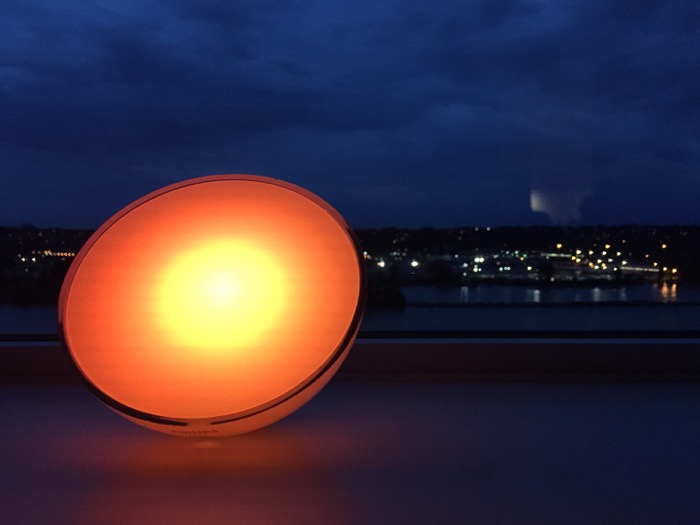 Philips Hue Go isn’t a product that many people need–it’s something that you want. A portable light that can change colours at the touch of a button, and that can also connect up to your Philips Hue Bridge to play with all of your other Hue Products … well, that’s pretty cool, but it doesn’t rank anywhere on a real “hierarchy of needs” list.
Philips Hue Go isn’t a product that many people need–it’s something that you want. A portable light that can change colours at the touch of a button, and that can also connect up to your Philips Hue Bridge to play with all of your other Hue Products … well, that’s pretty cool, but it doesn’t rank anywhere on a real “hierarchy of needs” list.
What is Philips Hue Go?
The Hue Go is a half a globe of white plastic. It has a little nub on the bottom, so it can sit flat on the table, shining light upwards if you want it to, or you can tilt it slightly, and it will shine that light up and out—a little like the Bat-signal on top of Gotham PD. Despite the wireless name, you can (and will) plug it in; that’s how you’ll recharge the built in battery for the unit.
There’s a single button on the bottom that can control it, assuming you’re not connecting it to your Philips Hue Bridge. More on that in a moment.
Unboxing Philips Hue Go
The box, like many of the other Philips Hue products out there, is black and decorated with rainbow text and product shots of people enjoying their Hue Go. One shot is a woman holding it like Mike Meyers holding his cup-o-ccino latte in So I Married An Axe Murderer. Both the Hue Go and Mike’s enormous coffee are comically large for someone to just hold, and if you’re planning on using the Hue Go that way I officially think you’re a weirdo. Chilling with a steaming cup of light is odd; you’re up-lit like a kid on halloween holding a flashlight under their chin. Just … don’t do it, okay?
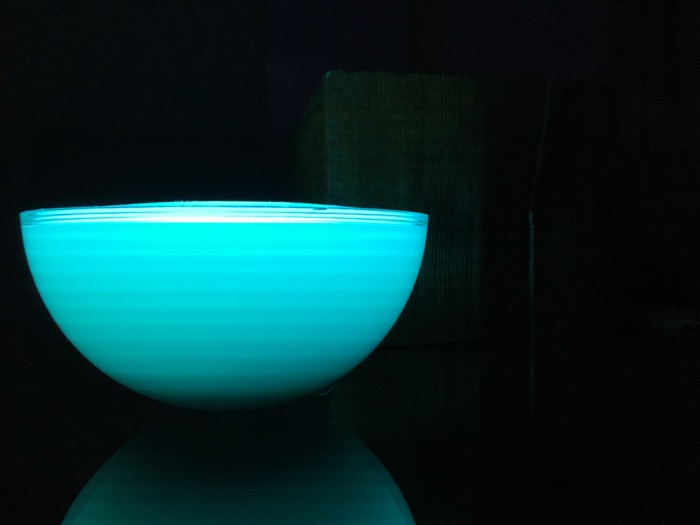
Please note that the “ripples” you see here are an effect of the light being photographed. They are not visible to the naked eye.
Anyway, taking it out of the box you have two pieces: the Hue Go, and the power cable. It’s a decently long cable—about six feet—that ends in a sideways wall-wart, so it’s outlet friendly. I plugged my Hue Go sample in and let it charge; Philips says that you should have a full charge from dead in about 1.5 hours, and that the Hue Go will last up to three hours when it’s operating in its unplugged state.
Charging and first use
When it was charged I fired it up by tapping the button on the bottom/back of the unit … and was shocked with how bright it is. This thing puts out 300 lumens, which doesn’t sound like a lot, but it certainly feels that way when it comes to life in your hands.
There’s a quick-start guide that will walk you through the operation of your Hue Go, as well as detailing the colours of light you can get out of it without needing a smartphone.
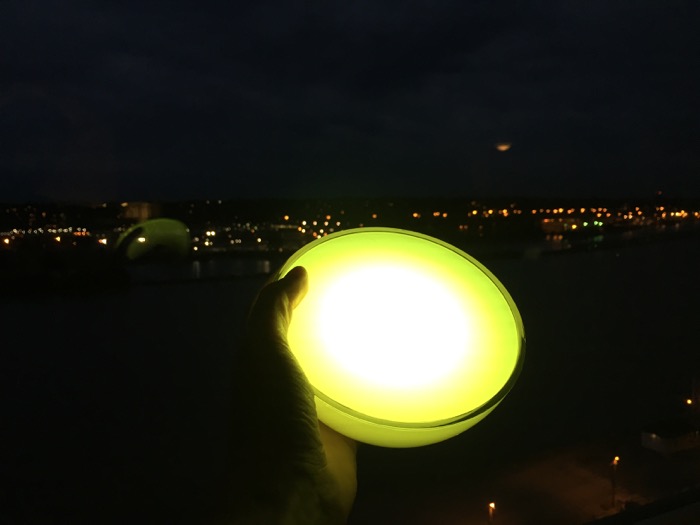 The first setting I experienced was warm, white light, which was brighter than I had expected. Natural white light felt brighter still. From there we get into what Philips calls “natural dynamic effects”—you can cycle through all of these with a single, short press. Cozy Candle cycles through warm, orange and yellow hues. Sunday Coffee is pink and purple. Meditation is purple and blue. Enchanted Forest is green and blue. And Night Aventure cycles from blue through to pink … and is represented by a heart in the listing. Va-va-va-voom.
The first setting I experienced was warm, white light, which was brighter than I had expected. Natural white light felt brighter still. From there we get into what Philips calls “natural dynamic effects”—you can cycle through all of these with a single, short press. Cozy Candle cycles through warm, orange and yellow hues. Sunday Coffee is pink and purple. Meditation is purple and blue. Enchanted Forest is green and blue. And Night Aventure cycles from blue through to pink … and is represented by a heart in the listing. Va-va-va-voom.
All of these settings pulse naturally and slowly through the colour ranges I’ve mentioned above, and all of them puzzled the heck out of my cat. He really didn’t know what to make of this alive/not-alive thing.
Want to browse through those settings in sequence without having to tap the button over and over again? Double-tap and hold to browse, then release the button when you get to a colour your like. If you double-tap and hold again it’ll reverse the sequence.
Battery powered lights!
The unique feature of the Hue Go is the fact that it’s battery operated. When you yank the power cord you’ll notice a few things: it stays on, but it becomes noticeably dimmer. That makes sense: use the power when you’ve got it, conserve when you don’t. Hue Go drops to 40% output when on battery, which is one of the things that gives it up to 3 hours of battery life. I can only imagine that it would last less than an hour at full crank.
When you’re on battery power and you want to conserve battery life temporarily, you can put the unit into standby with a two-second long press. After two hours in this mode it’ll shut off completely. When it’s in stand-by you can wake it up by tapping the power button, or by turning it back on with your Philips Hue app on your smartphone. If you want to shut it off completely, you can do so by pressing and holding the button for ten seconds. It’ll blink twice to let you know that it got the message.
 Fitting Hue Go into your Hue network
Fitting Hue Go into your Hue network
If you have a Philips Hue Bridge (full disclosure, I don’t at the moment) you can hook up Hue to it, and connect it to your existing Hue network. That means you can control it with timed effects, get specific colours from a colour-picker, set alarms, or use IFTTT (If This Then That) to setup recipes for your Hue Go to do stuff. meethue.com has a whole bunch of applications that make Hue Go a lot of fun to play with.
Conclusions
For me, Hue Go was handy to have. In a new living space sometimes you find yourself without lamps and lighting … and there’s nothing worse than being stuck in the dark if you don’t have to be. Hue Go was that handy little device that followed me from room to room, keeping me from stubbing my toe, and giving me light where I needed it.
It’s also a delightful little friend to have when you’re camping. What you really need is a solar charger to get it fired up in the day, so you can have a smart tent light at night.
Philips Hue Go is an accessory, not a necessity, but it’s one that I think is worth having. If you don’t want to spend the money to get into a full Hue system it’s a great way to sample what having coloured light on demand is like. If you do have a Hue system, it’s a great addition to your family. If none of these things sound appealing to you, your life won’t be any worse off without it. It’ll just be a little less cool.

